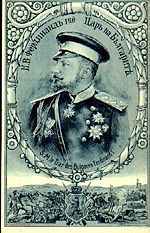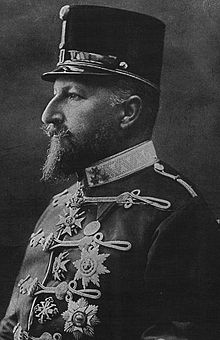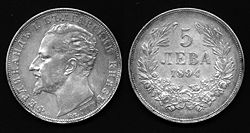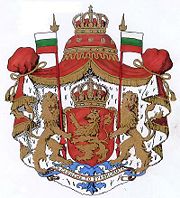Ferdinand I of Bulgaria
|
||||||||||||||||||||||||||||||
|
||||||||||||||||||||||||||||||
Ferdinand I, Tsar of Bulgaria (February 26, 1861 - September 10, 1948),[1] born Prince Ferdinand Maximilian Karl Leopold Maria of Saxe-Coburg and Gotha, was the Knjaz (Prince Regnant) and later Tsar of Bulgaria as well as an author, botanist, entomologist and philatelist.
Contents |
Family background
Ferdinand was born in Vienna, a prince of the Kohary branch of the ducal family of Saxe-Coburg-Gotha. He grew up in the cosmopolitan environment of Austro-Hungarian high nobility and also in their ancestral lands in Slovakia and in Germany. The Kohary, descending from a noble Slovak family of Hungary, were quite wealthy, holding for example the princely lands of Čabrad and Sitno, in what is now Slovakia. The family's property was also augmented by Clémentine of Orléans' remarkable dowry.
The son of Prince August of Saxe-Coburg-Kohary and his wife Clémentine of Orléans, daughter of king Louis Philippe I of the French, Ferdinand was a grand-nephew of Ernest I, Duke of Saxe-Coburg-Gotha and of Leopold I, first king of the Belgians. His father Augustus was a brother of Ferdinand II of Portugal, and also a first cousin to Queen Victoria, her husband Albert, Prince Consort, Empress Carlota of Mexico and her brother Leopold II of Belgium. These last two, Leopold and Carlota, were also first cousins of Ferdinand I's through his mother, a princess of Orléans. This made the Belgian siblings his first cousins, as well as his first cousins once removed (his father's first cousins). Indeed, the ducal family of Saxe-Coburg-Gotha had contrived to occupy, either by marriage or by direct election, several European thrones in the course of the 19th century. Following the family trend, Ferdinand was himself to found the royal dynasty of Bulgaria.
Ferdinand had some ancestry from medieval rulers of Bulgaria, descents from both his mother's and father's side.
Prince of Bulgaria
Bulgaria replaced its first Knjaz (Prince), Alexander of Battenberg in 1886, only seven years after he had been installed.[2] Ferdinand was proclaimed Knjaz (Prince Regnant) of autonomous Bulgaria on 7 July 1887 in the Gregorian calendar (the "New Style" used hereinafter).[3] The throne had been previously offered, before Ferdinand's acceptance, from Denmark to the Caucasus and even to the King of Romania.[4] His accession was greeted with disbelief in many of the royal houses of Europe. Queen Victoria, his father's first cousin, stated to her Prime Minister, "He is totally unfit, ... delicate, eccentric and effeminate .. Should be stopped at once."[5] To the amazement of his initial detractors, Ferdinand generally made a success of his reign.[6]
Bulgaria's domestic political life was dominated during the early years of Ferdinand's reign by liberal party leader Stefan Stambolov, whose foreign policy saw a marked cooling in relations with Russia, formerly seen as Bulgaria's protector.
Personal life
Ferdinand was bisexual throughout his life, but up to middle age, his proclivities for women predominated.[7] Ferdinand's bisexuality was both well-known and exploited throughout European diplomatic circles.
Ferdinand entered a marriage of convenience[8] with Princess Marie Louise of Bourbon-Parma, daughter of Roberto I of Parma on April 20, 1893 at the Villa Pianore in Lucca in Italy, producing four children:
- Boris III (1894–1943)
- Kyril (1895–1945)
- Eudoxia (1898–1985)
- Nadejda (1899–1958). Married Duke Albrecht Eugen of Württemberg.
Marie Louise died on 31 January 1899 after giving birth to her youngest daughter. Ferdinand did not think again about marriage until his mother, Princess Clémentine died in 1907. To satisfy dynastic obligations and to provide his children with a mother figure, Ferdinand married Eleonore Caroline Gasparine Louise, Princess Reuss-Köstritz, on 28 February 1908.[9]
Ferdinand's regular holidays on Capri, then a famous haunt for wealthy gay men, was common knowledge in royal courts throughout Europe.[10] It became the custom for visiting dignitaries seeking favour from Ferdinand to be accompanied by a handsome young equerry. A much recounted tale of First World War vintage centred around the occasion the Bulgarian war minister arrived at Ferdinand's quarters to discuss an urgent military matter, only to discover that Ferdinand had left for a picnic with a young man he had just met.
|
||||||||||||||||||||||||||||||||
Stambolov's fall (May 1894) and subsequent assassination (July 1895) paved the way for a reconciliation of Bulgaria with Russia, effected in February 1896 with the conversion of the infant Prince Boris from Roman Catholicism to Eastern Orthodox Christianity. However, this move earned him the animosity of his Catholic Austrian relatives, particularly that of his uncle, Emperor Franz Josef I of Austria.
Tsar of Bulgaria

Ferdinand became Tsar of Bulgaria upon that country's declaration of independence from the Ottoman Empire on 5 October 1908 (celebrated on 22 September). The Declaration of Independence was proclaimed at the Saint Forty Martyrs Church in Turnovo. It was accepted by Turkey and the other European powers.[11]
Ferdinand was known for being quite a character. On a visit to German Emperor Wilhelm II, his second cousin once removed, in 1909, Ferdinand was leaning out of a window of the New Palace in Potsdam when the Emperor came up behind him and slapped him on the bottom. Ferdinand was affronted by the gesture and the Emperor apologised. Ferdinand however exacted his revenge by awarding a valuable arms contract he had intended to give to the Krupps factory in Essen to French arms manufacturer Schneider-Cruseot.[12] Another incident particularly occurred on his journey to the funeral of his second cousin, British King Edward VII in 1910. A tussle broke out on where his private railway carriage would be positioned in relation to the heir to the Austro-Hungarian throne, Archduke Franz Ferdinand. The Archduke won out, having his carriage positioned directly behind the engine. Ferdinand's was placed directly behind. Realising the dining car of the train was behind his own carriage, Ferdinand obtained his revenge on the Archduke by refusing him entry through his own carriage to the dining car.[13]
Balkan Wars
Like many a ruler of an Orthodox land before him, Ferdinand had a "dream of a new Byzantium".[14] In 1912, Ferdinand joined the other Balkan states in an assault on the Ottoman Empire to free occupied territories. He saw this war as a new crusade declaring it, "a just, great and sacred struggle of the Cross against the Crescent."[15] Bulgaria contributed the most and also lost the greatest number of soldiers. The great powers insisted on the creation of an independent Albania.[16] Soon after, Bulgaria attacked its recent allies Serbia, Greece and Romania and was defeated. The Treaty of Bucharest in 1913 gave little territorial gains to Bulgaria. A tiny area of land giving access to the Aegean Sea was secured.[17]
First World War and abdication
On 11 October 1915, the Bulgarian army attacked Serbia after signing a treaty with Austria-Hungary and Germany which stated that Bulgaria would gain the territory she sought at the expense of Serbia. See Serbian Campaign (World War I) for details. Ferdinand was not an admirer of German Emperor Wilhelm II (his second cousin once removed) or Emperor of Austria Franz Josef I who he described as "that idiot, that old dotard of a Francis Joseph".[18] But Ferdinand wanted extra territorial gains after the humiliation of the Balkan Wars. This did however mean forming an alliance with his former enemy, the Ottoman Empire.
At first the war went well, Serbia was defeated and Bulgaria took possession of most of the disputed territory of Macedonia. For the next two years, the Bulgarian army fought a defensive war against the Allied army based in Greece. A small part of the Bulgarian army was involved in the conquest of Romania in 1916.
Then, in the fall of 1918, the Bulgarian army was badly beaten by an attack from the Allied forces in Greece. With his army shattered, Tsar Ferdinand abdicated to save the Bulgarian throne in favour of his eldest son who became Tsar Boris III on 3 October 1918.[19] Under new leadership, Bulgaria surrendered to the Allies and as a consequence, lost not only the additional territory it had fought for in the major conflict, but also the territory it had won after the Balkan Wars giving access to the Aegean Sea.[20]
Exile and Death
|
||||||||||||
|
||||||||||||
After his abdication, Ferdinand returned to live in Coburg, Germany. He had managed to salvage much of his fortune and was able to live in some style.[21] He saw his being in exile simply as one of the hazards of kingship.[22] He commented, "Kings in exile are more philosophic under reverses than ordinary individuals; but our philosophy is primarily the result of tradition and breeding, and do not forget that pride is an important item in the making of a monarch. We are disciplined from the day of our birth and taught the avoidance of all outward signs of emotion. The skeleton sits forever with us at the feast. It may mean murder, it may mean abdication, but it serves always to remind us of the unexpected. Therefore we are prepared and nothing comes in the nature of a catastrophe. The main thing in life is to support any condition of bodily or spiritual exile with dignity. If one sups with sorrow, one need not invite the world to see you eat."[23] He was pleased that the throne could pass to his son. Ferdinand was not displeased with exile and spent most of his time devoted to artistic endeavours, gardening, travel and natural history. However, he would live to see the collapse of everything he had held to be precious in life.[24] His eldest son and successor, Boris III, died under mysterious circumstances after returning from a visit to Hitler in Germany in 1943. Boris III's son, Simeon II, succeeded him only to be deposed in 1946, ending the Bulgarian monarchy. The Kingdom of Bulgaria was succeeded by the People's Republic of Bulgaria, under which his sole surviving son, Kyril, was executed. On hearing of his son's death he said, "Everything is collapsing around me."[25] He died a broken man in Bürglaß-Schlösschen on September 10, 1948 in Coburg, Germany, cradle of the Saxe-Coburg-Gotha dynasty. Ferdinand I is buried there in St. Augustin's Roman Catholic Church.[26]
Ancestors
| Ferdinand I of Bulgaria | Father: August of Saxe-Coburg and Gotha, 5th Prince of Kohary |
Paternal Grandfather: Ferdinand of Saxe-Coburg and Gotha, 4th Prince of Kohary |
Paternal Great-grandfather: Francis, Duke of Saxe-Coburg-Saalfeld |
| Paternal Great-grandmother: Augusta Reuss-Ebersdorf |
|||
| Paternal Grandmother: Maria Antonia Koháry de Csábrág |
Paternal Great-grandfather: Ferenc József, Prince of Koháry de Csábrág |
||
| Paternal Great-grandmother: Maria Antonia of Waldstein zu Wartenberg |
|||
| Mother: Princess Clémentine of Orléans |
Maternal Grandfather: Louis-Philippe of France |
Maternal Great-grandfather: Louis Philippe II, Duke of Orléans |
|
| Maternal Great-grandmother: Louise Marie Adélaïde de Bourbon-Penthièvre |
|||
| Maternal Grandmother: Maria Amalia of the Two Sicilies |
Maternal Great-grandfather: Ferdinand I of the Two Sicilies |
||
| Maternal Great-grandmother: Marie Caroline of Austria |
External links
References
- ↑ Line of Succession by Jiri Louda, Table 149
- ↑ The Last Courts of Europe by Jeffrey Finestone, p.227
- ↑ ibid
- ↑ Lines of Succession by Jiri Louda, p.297
- ↑ Crowns In Conflict by Theo Aronson, p.83
- ↑ ibid
- ↑ Constant, Stephen (1986). Foxy Ferdinand, 1861-1948, Tsar of Bulgaria. London: Sidgwick and Jackson. pp. 96. ISBN 0-238-98515-1.
- ↑ Constant, Stephen (1986). Foxy Ferdinand, 1861-1948, Tsar of Bulgaria. London: Sidgwick and Jackson. pp. 143. ISBN 0-238-98515-1.
- ↑ Crowns In Conflict by Theo Aronson, p.85
- ↑ Constant, Stephen (1986). Foxy Ferdinand, 1861-1948, Tsar of Bulgaria. London: Sidgwick and Jackson. pp. 266. ISBN 0-238-98515-1.
- ↑ Lines of Succession by Jiri Louda, p.297
- ↑ Crowns In Conflict by Theo Aronson, pp.8-9
- ↑ ibid, p.7
- ↑ ibid, p.86
- ↑ Crowns In Conflict by Theo Aronson, p. 87
- ↑ Lines of Succession by Jiri Louda, p.297
- ↑ ibid
- ↑ Crowns In Conflict by Theo Aronson, p.126
- ↑ The Kaiser: Warlord Of The Second Reich by Alan Palmer, p.206
- ↑ ibid
- ↑ Crowns in Conflict by Theo Aronson, p.201
- ↑ ibid
- ↑ ibid, p.175
- ↑ ibid
- ↑ ibid, p.202
- ↑ Lines of Succession by Jiri Louda, Table 149
Books
- Aronson, Theo (1986). Crowns In Conflict: The Triumph And The Tragedy Of European Monarchy, 1910-1918. London: J.Murray. ISBN 0-7195-4279-0.
- Finestone, Jeffrey (1981). The Last Courts of Europe. London: J.M.Dent & Sons Ltd. ISBN 0 460 04519 9.
- Louda, Jiri; Michael Maclagan (1981). Lines of Succession. London: Orbis Publishing Ltd. ISBN 0 460 04519 9.
- Constant, Stephen (1986). Foxy Ferdinand, 1861-1948, Tsar of Bulgaria. London: Sidgwick and Jackson. ISBN 0-238-98515-1.
- Palmer, Alan (1978). The Kaiser: Warlord Of The Second Reich. London: Weidenfeld and Nicolson. ISBN 0-297-77393-3.
|
Ferdinand I of Bulgaria
House of Saxe-Coburg-Gotha
Cadet branch of the House of Wettin
Born: 26 February 1861 Died: 10 September 1948 |
||
| Regnal titles | ||
|---|---|---|
| Preceded by Alexander I |
Prince of Bulgaria 7 July 1887 – 5 October 1908 |
proclaimed Tsar Bulgarian indipendence
from Ottoman Empire |
| New title Principality elevated
to kingdom |
Tsar of Bulgaria 5 October 1908 – 3 October 1918 |
Succeeded by Boris III |
|
||||||||||||||||||||||



